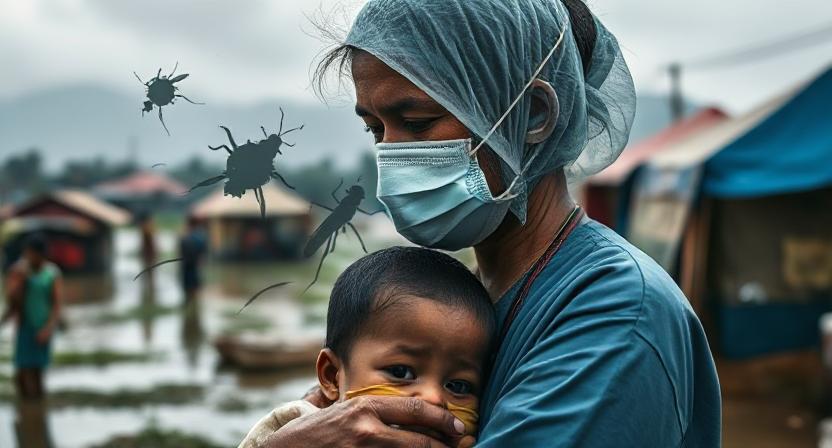
NU
Fri, 04 July 2025

Multiple cholera cases have been reported from different regions of the country, including the Kathmandu Valley, subsequent to the commencement of monsoon rains. The simultaneous health emergencies indicate an impending "triple health crisis" for Nepal, a risk significantly intensified by the current monsoon season.
Adding significantly to public concerns, Nepal recorded its first COVID-19 death in over two years on June 24, 2025, when a 39-year-old woman in Biratnagar tragically succumbed to the virus. This stark event underscores that COVID-19 continues to claim lives.
Overall, 249 COVID-19 cases have been confirmed across 31 districts of Nepal from last December to the beginning of July 2025. In response to the widening spread of both COVID-19 and other seasonal illnesses, authorities, including the Ministry of Health and Population (MoHP), are urgently intensifying surveillance at key border checkpoints and within communities to contain further transmission.
Nepal's public health authorities are observing a notable increase in other infectious diseases, especially dengue and cholera, indicating a wider health crisis as the monsoon season intensifies, beyond the immediate concern of COVID-19.
The Epidemiology and Disease Control Division (EDCD) has noted a consistent increase in dengue infections since the beginning of 2025. A notable surge occurred in Epi Week 26, which recorded 59 new cases, marking the highest single-week increase this year.
Dengue has now been identified in 73 districts nationwide. Bagmati Province remains the most affected region, accounting for 192 cumulative cases, with the capital, Kathmandu, registering the highest numbers within the province. Health officials are cautioning that the period from July to October will represent the peak risk for dengue, with projections indicating up to 60,000 potential infections across the country in 2025.
Adding to the health challenges, the confirmed presence of the highly infectious Vibrio cholera 01 Ogawa serotype as of July 4, 2025, raises particular concerns for potential cholera outbreaks. Areas within the Kathmandu Valley, including Kathmandu, Lalitpur, and Bhaktapur, are considered especially vulnerable to monsoon-related cholera outbreaks.
This vulnerability is underscored by past trends; last year, 95 cholera cases were confirmed across various districts, including Kathmandu, Lalitpur, Kailali, and Pyuthan. The MoHP has further identified 30 districts as highly susceptible to cholera outbreaks, primarily due to pre-existing challenges with water and sanitation infrastructure.
The upward trend in these multiple diseases is driven by several critical factors, primarily exacerbated by the ongoing monsoon season. A significant contributor to the spread is the daily movement of migrant workers returning from India, as outbreaks in Nepal historically mirror trends in neighbouring countries.
Public health officials also note a perceived decline in public adherence to safety protocols and a reduced awareness of ongoing risks among the population. This waning vigilance further complicates efforts to control disease transmission.
A concerning challenge for the national health response is the reported shortage of rapid diagnostic test kits. This scarcity significantly hinders comprehensive testing and surveillance for various illnesses, making it more difficult to track and contain outbreaks effectively.
Furthermore, the emergence of new Omicron sub-variants for COVID-19, coupled with the monsoon season's favourable conditions for mosquito breeding and water contamination, are explicit drivers behind these recent spikes in infections across the country. These environmental and biological factors combine to create an ideal environment for the spread of disease.
Public Health Response and Recommendations In light of these escalating developments, the MoHP has issued a direct appeal, urging stringent adherence to health protocols: consistent mask-wearing, frequent handwashing with soap and water or using sanitisers, and maintaining personal hygiene to prevent respiratory and waterborne ailments. Individuals from affected areas or displaying COVID-19-like symptoms are strongly advised to self-quarantine or isolate.
To mitigate increased risks, the MoHP has intensified COVID-19 surveillance by establishing health screening desks at 17 border checkpoints across the country.
According to Dr Prakash Budathoki, spokesperson of MoHP, COVID-19 testing is being carried out at these health desks using the RDT method. Authorities are actively seeking to procure an additional 20,000 rapid diagnostic test kits and are engaging with the World Health Organisation (WHO) Nepal office for further assistance.
In a significant step, authorities in the capital are poised to relaunch COVID-19 vaccination campaigns, with health experts underscoring the critical need for eligible populations to receive second booster shots against emerging Omicron variants.
Concurrently, the government has allocated Rs 100 million for nationwide dengue control efforts, specifically targeting mosquito search and destruction initiatives. Complementing these measures, the Kathmandu Metropolitan City has initiated awareness drives promoting safe drinking water and hand hygiene, forming a crucial component of a broader cholera elimination plan.
This comprehensive cholera strategy encompasses a multi-sectoral approach and potential mass vaccination. Healthcare experts collectively advocate for a thorough response, emphasising the necessity of enhanced surveillance, superior water, sanitation, and hygiene (WASH) practices, extensive social mobilisation, and efficient treatment protocols to curtail the transmission of all existing infections.
The coming weeks will ultimately reveal the full extent of the monsoon's impact on Nepal's health resilience.